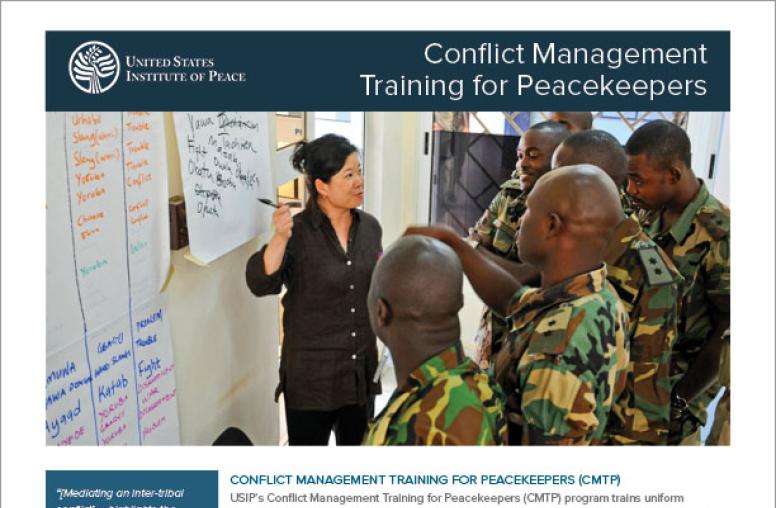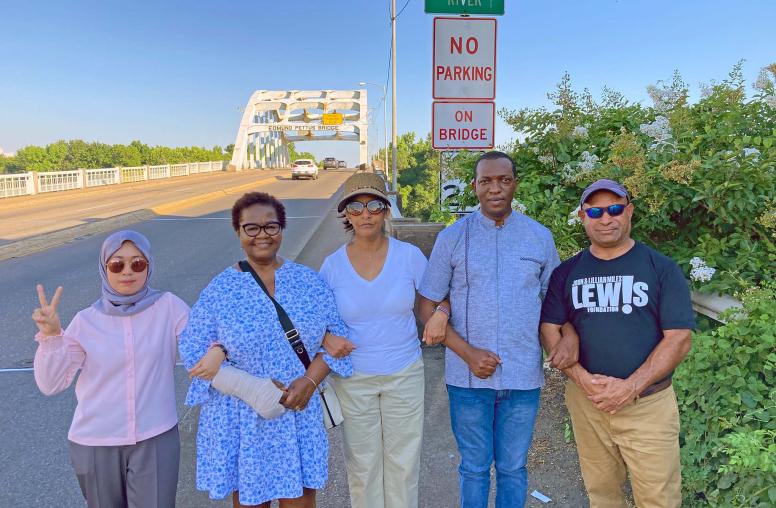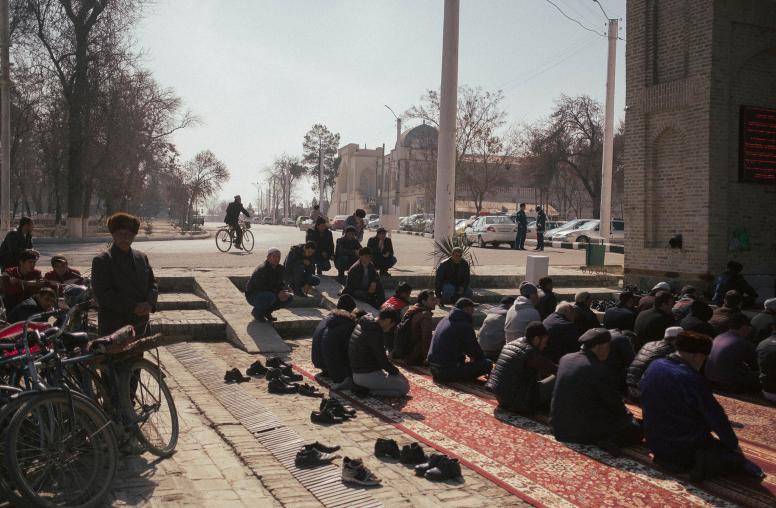Brains and Biases
Culturally Attuned Podcast: Episode 16
The human brain is hardwired to constantly scan for cues that signal safety, trustworthiness, and social desirability among others. As we work among people of different races and cultures, it’s vital that we stay aware of these patterns within our own selves, because they drive our biases. If we don’t notice our own patterns, they can obstruct valuable connections with people around us.
How can we work effectively across our world’s cultural divides? USIP and Burning Man Project travel to that frontier, hearing stories and practical lessons for working in unfamiliar cultures. The Culturally Attuned podcast complements USIP’s online, self-paced course on Cultural Synergy. Both help us cultivate the skills we need to do good work in a diverse world.
Transcript
This is Culturally Attuned. Brought to you by the United States Institute of Peace, in partnership with Burning Man Project.
Kerley Most
And it's a biological neurological thing to scan a room and go towards the person that looks like you. Because it's automatic, it’s similarity, and if this person is similar, it's more likely that this person is not going to be from a different tribe, they wouldn’t attack me. So it's a brain question. It's impossible for me to work as a humanitarian anywhere in the world without understanding that because my biases, who I decide that it's worthy, and who I decided that is unworthy, is going to play a role in everything I do.
Dominic Kiraly
I’m Dominic Kiraly and you just heard from Dr. Kerley Most, a psychotherapist and international humanitarian who spent over a decade in Guinea working on community development.
In this second episode with Kerley, we dive deep into the topic of bias – a preconception for or against a thing, person or group compared with another.
Bias is insidious in that it is most often unconscious, and it can lead us to regard or treat other people unfairly. When we work in unfamiliar cross-cultural environments, bias can shape the ways we relate – or fail to relate – with people who are different from us.
Kerley Most
Yes, I'm Brazilian, and I was born and raised in Brazil. And I've been living here in the United States for 13 years now. But prior to this time, I spent 11 years in Guinea, West Africa, as a humanitarian. And now I traveled the world supporting humanitarians to find wellness, and to process critical incidents. I am a licensed psychotherapist, and I have a Ph.D in counselor education and clinical supervision. I am in an interracial relationship. And I have biracial children. So social justice is very important to me.
When I was in West Africa, I used to wear lots of West African clothes. I was in Guinea. When newcomers came in the environments that I used to be, I was normally met with eyes of disempowerment. I would try to talk to people, and they would just dismiss me or not even look at me. What I quickly realized was that the fact that I was wearing African clothes made the newcomers think that I was African. And when other newcomers came, and they experienced me, they knew I was a humanitarian, their behavior towards me was much more attuned.
So our energy can create connection or disconnection. And when people are meeting the other, the brain will start to scan for cues of social desirability. If the other person perceives them as not desirable, they will disengage with me.
So another factor also that can create a better connection with other people is awareness of what I represent. We have our bodies in our bodies or our containers, and I carry my container wherever I go. If I'm black, I carry my black container. If I'm white, I'll carry my white container. And what I represent has meaning to people in other cultures. Do you know what being black means to the culture that you're connecting with? Do you know what being white means to the culture? In my own story, as a Brazilian female, I held a lot of power of decision, my own life, and I was seeing as a free female. When I went to West Africa, I instantly lost power. Because I was a female, and I was black and in the villages, females didn't hold so much power. The same thing did not happen to my husband. As a white male, the moment he got into Africa, he received instant privilege because of what it meant to be white. And because of colonialism. So it's very important to remember those two things, that my connection will be deeper or not, according to the way I react to people and according to the way I present myself.
Dominic Kiraly
Race and gender affect the degree of power that a given person holds in our communities and societies. Dr. Kerley Most explains how power dynamics are rooted in the physical bodies we inhabit.
Kerley Most
Normally, we assume that people connecting with us have the same level of power. Because in our American culture, and in many cultures of the world, we have the idea of meritocracy, and the idea of individualism. So you’re an individual. You’re like me. But when I walk around, and I hold the notion that you're like me, of course, I'm human, and I'm worthy of being accepted and seen. But I'm not like you. I'm black. So when I connect with people from different races, and cultures, it's important for me to be aware of the power differentiator. If I'm not aware of that. If I have the illusion of individualism, that that person has the same power that I do, then I'm not supporting that person. And again, not in a paternalistic manner. But I need to see that there is a power, lack of balance, a power imbalance happening in every connection that we have with other human beings that do not carry the bodies that we do. So it’s important to be aware of. And that can support us doing the work of humanitarians because we want to have positive encounters.
So people who are white who people will carry a white body, people who carry who identify as white carry a wide body, I normally say, be aware of the power that your presence holds, just the fact of being the room means power. So if you were to have that type of power, you need to act on the contrary. So you need to embrace attitudes, body actions of humility, and openness, and of validation, being very careful about that. Now, if you carry a body that has historically been perceived as disempowered, like a black body, or a body of color. And I say not only black, but around the world, Asian and other types of bodies that do not carry the instant privilege, then you need to be aware, they need to manage the loss of power that you will experience when entering into a culture that's different from yours.
An African male who is very well adapted in Africa, as an executive, will struggle greatly when he comes to America, because of racism because of the way American history has been. He will automatically lose a lot of his power and lose his voice and that can be very challenging. So I help my clients to sit with the differences and to find ways to cope, either giving power away or becoming assertive in a way that is not aggressive.
Dominic Kiraly
As the brain pursues safety, it also scans for differences. If the brain perceives these differences in a non-threatening way, then it allows for a less arduous path toward connection and acceptance.
Kerley Most
There was a story that I read of this African American male, that he was super tall and had a deep voice. And he wanted to be a primary school teacher. It was very hard for him to find a job because the other teachers found him threatening. It had nothing to do with his behavior. It had to do with the perception of tall and deep voice threatening because the brain sensed the image. It's a challenging business, but a beautiful business when you decide to sit with discomfort in your body and confront it and take deep breaths and say, Okay, I'm going to sit with my discomfort. And I'm going to ascribe worthiness, and get involved in this relationship, and do not disconnect.
So it's liberating when we are able to sit with the different and be open. Because then relationships and connections help to challenge biases. Every biases I've have been challenged by relationships. So when I'm coming up and I say to myself enough, and I become curious to engage in conversation, then I can develop a relationship and that relationship shift is my perspective. Oh, that perception was not accurate. So long road.
Dominic Kiraly
Sitting with the discomfort of difference is very challenging, but it can create a space for dialogue, openness, learning, and connection. How we react to and process new experiences can create a blueprint for deeper cultural understanding and long-term adaptation and resilience. Dr. Kerley Most shares a personal story on the importance of being open and adaptive, even as our brains are scanning for safety.
Kerley Most
I think it's very important to be open to adapt to new situations. So people who are resilient are people who just deal with what's presented before them, and adapt quickly.
I was in this big bus and wearing African clothes, I had a head wrap. And I sat, and suddenly, this man comes and he sits on my lap. And I'm like, “Oh my god” and I looked around, everybody was just sitting there going about their business. And some other people are sitting on people's lap too. And then I said, Okay, relax because the world's going to be very different and we need to adapt to what comes to us.
But the other very important point also, that is connected to the ability to adapt, is self awareness, and self regulation, the ability to sit with discomfort, manage discomfort internally, without showing it outwardly. I couldn't have told the man,”Get out!” He had no idea that I was going through this process. But the ability to self-regulate helps to adapt better and to become more self aware.
The first way that you can connect with your energy is paying attention to your body, when you, the brain will try to do only two things to keep you safe and to help you to connect with others. In order to connect, the brain first is going to check the environment to see that you're safe. So your body is going to feel constricted in a new environment, when everybody else looks different from you. So it's a natural body reaction. So when I'm aware of my body, in this natural body reactions, I can tell myself, “Oh, this is normal. It's just my brain telling me to be safe. I'm safe and here because I want to be here.” So you can take deep breaths, connect with your body and manage your energy into yourself, “I'm here because I want to be here. The people I see before me are potential friends.” And then my energy shifts.
And another way, a very quick tip to shift my energy when I am in international encounters is to tell my mind, the internal mantra, “This person in front of me is the best celebrity I love. This person in front of me is the celebrity and crazy about” because that will shift their energy to like “Ah, what will you please tell me about you? What do you eat for breakfast.” That will change the energy also.
Dominic Kiraly
Maintaining a relaxed posture can also send messages of safety and connection, and signal openness to a positive relationship. Kerley Most discusses body language and the role active listening plays in engaging deeply in a respectful and culturally appropriate manner with people who differ from those we are used to.
Kerley Most
I'm Brazilian, and in Brazil, if you come to a meeting, and go straight to the point, it's unthinkable. And if you go to Brazil and you don’t know that, and you go in there and say “Do this, this, this,” you won't be successful. So sitting and paying attention. I think that's the point: Sitting, paying attention, listening and adopting a learner perspective. Very open. You don't have all the answers. I'm here to learn.
When we approach human communication, and building relationships and communicating across cultures, it's important to understand that most humanitarians come from a Western perspective. When we are operating in a non-western perspective, interestingly, a significant part of the world is built by oral cultures, people who highly value talking and being heard.
From a Western perspective, we are focused on getting to the point and we will approach the communication with the goal of getting to the point. So, with those distinctive goals becomes very challenging to have proper communication. So, what do we do? We then adjust and place ourselves in a position that we can increase our ability to listen. The greatest leaders that we know, and very effective peacemakers, are the people who are able to listen, and listen well. So, the first step then, in order to be successful in cross-cultural communication is to increase your ability to listen, to listen deeply. And also to decrease your focus on the “Get to the point” unless you’re functioning with people from a culture that getting to the point is okay. So I think that's the bedrock of proper communication.
Of course, then also you can use some body expressions that there will communicate openness: avoiding crossing your arms, avoiding keeping your eyes away from the person you're talking to, avoiding distractions, avoiding open criticism, because most of the cultures are orally orientating are cultures that want to save face. And if you express something that can be abrasive, at first, the communication is broken, because the person felt offended. So tending to the responsibility of the sender. When I engage international multicultural communication, I'm responsible for creating a sense of safety so that the person listening to me will be able to respond and not to feel threatened by what I'm saying, even when I don't know the cultural codes, and especially when I don't know the cultural codes, I need to put myself in a position of listening, in a position of body and facial expressions that communicate openness.
Dominic Kiraly
In this podcast Dr. Kerley Most challenged us to examine our biases and be conscious of power dynamics when we engage with others. Active, and ample, listening, particularly in cross-cultural contexts, will yield the deepest expressions of safety, connection and trust. In particular, anyone who is working in a culture that is not their own, whether for business or as a non-profit professional, must be conscious of the power dynamics they wield with their counterparts in order to facilitate open communication and mutual understanding.
What power do you carry in your physical body that manifests itself socially and culturally? How might this impact the way you are perceived in other cultures?
Thanks for listening to this episode of Culturally Attuned, produced by Dominic Kiraly at the United States Institute of Peace, and in collaboration with our partner, Burning Man Project. I’m Dominic Kiraly. If you like what you heard, be sure to tune in to more episodes and subscribe wherever you get your podcasts.
Culturally Attuned Credits
Produced, engineered and narrated: Dominic Kiraly
Co-Creators: Christopher Breedlove, Kim Cook



